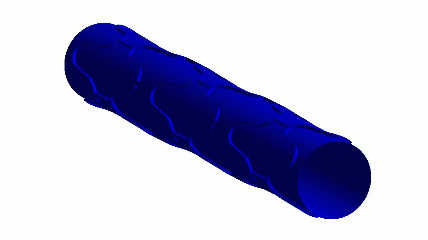Homework, Quizzes, Simulation Examples — Metal Plasticity — Lesson 6
Simulation Examples
Several simulation examples are provided here. Each comes with a description file, video instruction, and Ansys simulation file. All of the simulations are conducted using Ansys simulation solutions. Download the student version of Ansys here.
(1) Twisting Copper Wires
This simulation uses a vivid example to illustrate the idea of metal plasticity: four copper wires being twisted to form one thicker wire. Plastic deformation is essential for these wires to bind together. Compare the two simulations conducted in this example and enhance your understanding of permanent deformation and plasticity. Download the zip file and extract the contents. Go through the Readme file. Follow along with the provided How To Video file.


(2) Cold Rolling
Cold rolling is a process of letting metal go through rollers to compress the thickness at a temperature lower than the recrystallization temperature (usually room temperature). This simulation illustrates the process of cold rolling of aluminum. Follow the instructions of the documentation to reproduce the analysis with and without plasticity and compare the results. Download the zip file and extract the contents. Go through the Readme file. Follow along with the provided How To Video file.


(3) Cardiovascular Stent Analysis
This model simulates the rapid expansion of a stent in a coronary artery. Balloon angioplasty is used to expand the stent, break up the plaque and push the coronary artery outward. During this process, plastic deformation happens in the metal stent. This permanent deformation provides support and keeps the artery open. Download the zip file and extract the contents. Go through the Readme file. Follow along with the provided How To Video file.


Homework
(1) Springback of sheet metal forming
Springback is the behavior of a material is recovering the angular deformation to an extent after being bent. It is an inherent behavior of sheet metal forming, where a metal sheet is
fashioned through mechanical behavior. This document shows the workflow of simulating a metal forming and springback process using Ansys explicit dynamics analysis and static
structural analysis. The metal forming process is simulated using explicit dynamics analysis, and the springback is done in static structural analysis as the dynamic effect is negligible during the
springback process. Redo the simulation and answer the following questions:
(a) Why does springback happen?
(b) What information is needed to conduct a springback analysis after obtaining the metal forming result?
Download the zip file and extract the contents. Go through the Readme file. Follow along with the provided How To Video file.

(2) Comparison of Steel Yielding and Concrete Cracking
This model simulates the post-elastic behavior of a rebar-reinforced concrete beam under impact loading. The beam is simply supported and loaded at the mid-span. After the yield criterion is met in the steel rebar, it exhibits plastic behavior. The concrete, however, immediately starts to crack after the maximum tensile stress is reached. Redo the simulation, compare the different behaviors of concrete and steel, and answer the following questions:
(a) Steel is less prone to cracking and failure, so why not use steel for the entire beam? In other words, what is the benefit of combining these two materials?
(b) Compare the stress- strain curves of steel and concrete. For a unit volume of concrete and steel, how much energy can each material absorb upon failure under tensile loading, providing steel completely fails when it reaches the ultimate strength and concrete fails once it reaches its tensile strength? (Hint, energy is the area under the stress-strain curve).
Download the zip file and extract the contents. Go through the Readme file. Follow along with the provided How To Video file.


